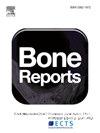利用拉曼光谱和机器学习算法预测离体人股骨皮质骨的生物力学特性
IF 2.6
Q3 ENDOCRINOLOGY & METABOLISM
引用次数: 0
摘要
本研究将拉曼光谱(RS)应用于离体人尸体股骨骨干中段皮质骨标本(118例供体,年龄21-101岁),通过机器学习(ML)模型预测断裂韧性特性。光谱特征,连同人口统计学变量(年龄、性别)和结构参数(皮质孔隙度、体积骨矿物质密度),被输入到支持向量回归(SVR)、极端树回归(ETR)、极端梯度增强(XGB)和集合模型中,以预测断裂韧性指标,如裂纹起裂韧性(Kinit)和断裂能量(j积分)。特征选择基于拉曼衍生的矿物和有机基质参数,如ν1Phosphate (PO4)/CH2-wag, ν1PO4/Amide I等,以捕获骨的复杂组成。我们的研究结果表明,集成模型始终优于单个模型,使用集成方法预测裂纹起裂韧性(Kinit)的效果最好。其决定系数(R2)为0.623,均方根误差(RMSE)为1.320,平均绝对误差(MAE)为1.015,平均百分比绝对误差(MAPE)为0.134。对于裂纹扩展总能量(j积分)的预测,XGB模型的R2为0.737,RMSE为2.634,MAE为2.283,MAPE为0.240。该研究强调了结合矿物质量性质(MP)和有机基质性质(OMP)对提高预测精度的重要性。这项工作是首次将拉曼光谱与其他临床和结构特征结合起来预测人类皮质骨断裂韧性的研究,展示了人工智能(AI)和机器学习在推进骨骼研究方面的潜力。未来的研究可以集中在更大的数据集和更先进的建模技术上,以进一步提高预测能力。本文章由计算机程序翻译,如有差异,请以英文原文为准。
Prediction of biomechanical properties of ex vivo human femoral cortical bone using Raman spectroscopy and machine learning algorithms
This study applied Raman spectroscopy (RS) to ex vivo human cadaveric femoral mid-diaphysis cortical bone specimens (n = 118 donors; age range 21–101 years) to predict fracture toughness properties via machine learning (ML) models. Spectral features, together with demographic variables (age, sex) and structural parameters (cortical porosity, volumetric bone mineral density), were fed into support vector regression (SVR), extreme tree regression (ETR), extreme gradient boosting (XGB), and ensemble models to predict fracture-toughness metrics such as crack-initiation toughness (Kinit) and energy-to-fracture (J-integral). Feature selection was based on Raman-derived mineral and organic matrix parameters, such as ν1Phosphate (PO4)/CH2-wag, ν1PO4/Amide I, and others, to capture the complex composition of bone. Our results indicate that ensemble models consistently outperformed individual models, with the best performance for crack initiation toughness (Kinit) prediction being achieved using the ensemble approach. This yielded a coefficient of determination (R2) of 0.623, root-mean squared error (RMSE) of 1.320, mean absolute error (MAE) of 1.015, and mean percentage absolute error (MAPE) of 0.134. For prediction of the overall energy to propagate a crack (J-integral), the XGB model achieved an R2 of 0.737, RMSE of 2.634, MAE of 2.283, and MAPE of 0.240. This study highlights the importance of incorporating mineral quality properties (MP) and organic matrix properties (OMP) for enhanced prediction accuracy. This work represents the first-ever study combining Raman spectroscopy with other clinical and structural features to predict fracture toughness of human cortical bone, demonstrating the potential of artificial intelligence (AI) and ML in advancing bone research. Future studies could focus on larger datasets and more advanced modeling techniques to further improve predictive capabilities.
求助全文
通过发布文献求助,成功后即可免费获取论文全文。
去求助
来源期刊

Bone Reports
Medicine-Orthopedics and Sports Medicine
CiteScore
4.30
自引率
4.00%
发文量
444
审稿时长
57 days
期刊介绍:
Bone Reports is an interdisciplinary forum for the rapid publication of Original Research Articles and Case Reports across basic, translational and clinical aspects of bone and mineral metabolism. The journal publishes papers that are scientifically sound, with the peer review process focused principally on verifying sound methodologies, and correct data analysis and interpretation. We welcome studies either replicating or failing to replicate a previous study, and null findings. We fulfil a critical and current need to enhance research by publishing reproducibility studies and null findings.
 求助内容:
求助内容: 应助结果提醒方式:
应助结果提醒方式:


